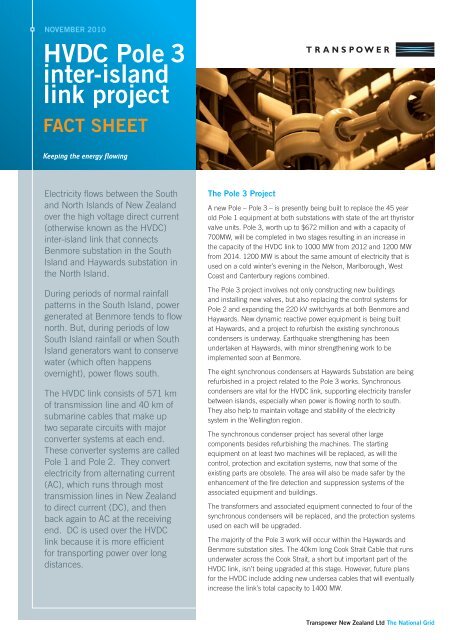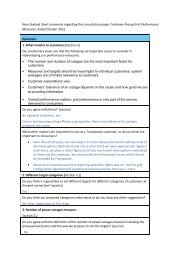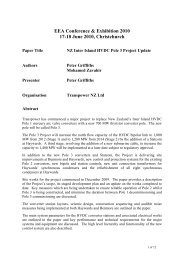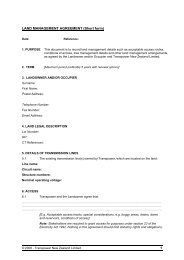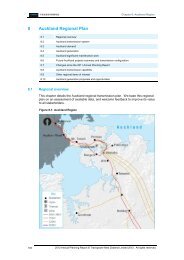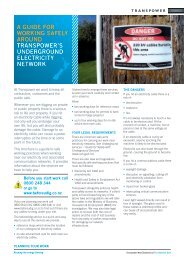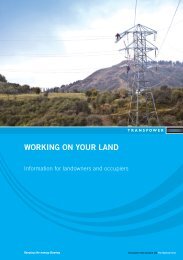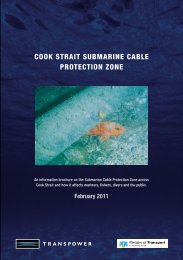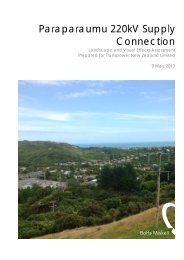HVDC Pole 3 Inter-island Link Project factsheet - Transpower
HVDC Pole 3 Inter-island Link Project factsheet - Transpower
HVDC Pole 3 Inter-island Link Project factsheet - Transpower
Create successful ePaper yourself
Turn your PDF publications into a flip-book with our unique Google optimized e-Paper software.
NOVEMBER 2010<strong>HVDC</strong> <strong>Pole</strong> 3inter-<strong>island</strong>link projectFACT SHEETElectricity flows between the Southand North Islands of New Zealandover the high voltage direct current(otherwise known as the <strong>HVDC</strong>)inter-<strong>island</strong> link that connectsBenmore substation in the SouthIsland and Haywards substation inthe North Island.During periods of normal rainfallpatterns in the South Island, powergenerated at Benmore tends to flownorth. But, during periods of lowSouth Island rainfall or when SouthIsland generators want to conservewater (which often happensovernight), power flows south.The <strong>HVDC</strong> link consists of 571 kmof transmission line and 40 km ofsubmarine cables that make uptwo separate circuits with majorconverter systems at each end.These converter systems are called<strong>Pole</strong> 1 and <strong>Pole</strong> 2. They convertelectricity from alternating current(AC), which runs through mosttransmission lines in New Zealandto direct current (DC), and thenback again to AC at the receivingend. DC is used over the <strong>HVDC</strong>link because it is more efficientfor transporting power over longdistances.The <strong>Pole</strong> 3 <strong>Project</strong>A new <strong>Pole</strong> – <strong>Pole</strong> 3 – is presently being built to replace the 45 yearold <strong>Pole</strong> 1 equipment at both substations with state of the art thyristorvalve units. <strong>Pole</strong> 3, worth up to $672 million and with a capacity of700MW, will be completed in two stages resulting in an increase inthe capacity of the <strong>HVDC</strong> link to 1000 MW from 2012 and 1200 MWfrom 2014. 1200 MW is about the same amount of electricity that isused on a cold winter’s evening in the Nelson, Marlborough, WestCoast and Canterbury regions combined.The <strong>Pole</strong> 3 project involves not only constructing new buildingsand installing new valves, but also replacing the control systems for<strong>Pole</strong> 2 and expanding the 220 kV switchyards at both Benmore andHaywards. New dynamic reactive power equipment is being builtat Haywards, and a project to refurbish the existing synchronouscondensers is underway. Earthquake strengthening has beenundertaken at Haywards, with minor strengthening work to beimplemented soon at Benmore.The eight synchronous condensers at Haywards Substation are beingrefurbished in a project related to the <strong>Pole</strong> 3 works. Synchronouscondensers are vital for the <strong>HVDC</strong> link, supporting electricity transferbetween <strong>island</strong>s, especially when power is flowing north to south.They also help to maintain voltage and stability of the electricitysystem in the Wellington region.The synchronous condenser project has several other largecomponents besides refurbishing the machines. The startingequipment on at least two machines will be replaced, as will thecontrol, protection and excitation systems, now that some of theexisting parts are obsolete. The area will also be made safer by theenhancement of the fire detection and suppression systems of theassociated equipment and buildings.The transformers and associated equipment connected to four of thesynchronous condensers will be replaced, and the protection systemsused on each will be upgraded.The majority of the <strong>Pole</strong> 3 work will occur within the Haywards andBenmore substation sites. The 40km long Cook Strait Cable that runsunderwater across the Cook Strait, a short but important part of the<strong>HVDC</strong> link, isn’t being upgraded at this stage. However, future plansfor the <strong>HVDC</strong> include adding new undersea cables that will eventuallyincrease the link’s total capacity to 1400 MW.
FACTS AND FIGURES• Total estimated cost is $672 million• Capacity of <strong>Pole</strong> 3 is 700 MW• Total capacity of the <strong>HVDC</strong> link will be increased to 1000 MW in 2012• Total capacity of the <strong>HVDC</strong> link will be increased to 1200 MW in 2014• The total length of <strong>HVDC</strong> transmission line 571km• The length of <strong>HVDC</strong> submarine cable is 40km• The <strong>HVDC</strong> was first commissioned 1965• The weight of each new transformer is 330 tonnes when operatingChallengesAs with any large infrastructure project,the <strong>Pole</strong> 3 project team faces severaltough challenges. Key among theseare logistics, building to meet rigorousseismic standards and the challenge ofworking in a live substation.The <strong>HVDC</strong> transformers needed atBenmore and Haywards are very largepieces of equipment - weighing around250 tonnes when transported. To getto their final destinations, they will beshipped to Wellington and Timaru andthen transported on specially reinforced26 axle truck and trailer units. Muchplanning is involved in deciding theroutes trucks must take to avoid all lowand weight restricted bridges, trafficand tight turns. Specialist heavy haulagecompanies are needed to do the job.Another challenge is to design <strong>Pole</strong> 3 sothat it can still operate after a sizeableearthquake – in this case, a one in 2,500year earthquake. A number of measuresare used, but the key seismic protectionmeasure is base isolation. Base isolatorsdo what they say – they isolate thebuilding above from the ground below.When the ground shakes, the baseisolators absorb much of the side toside movement, reducing the frequencyand degree of shake the buildingexperiences. This protects the buildingand the people and equipment inside it.Beyond the buildings themselves,detailed planning has gone into howthe actual electrical equipment willbe affected by earthquakes. Theequipment used in <strong>Pole</strong> 3 is tested bymanufacturers to establish how it wouldbe affected by earthquakes of differentlevels. The data from these tests guidethe team in designing the necessarysupport features to ensure equipmentcan move safely in an earthquakewithout touching other equipment andstructures.The three state-of-the-art thyristor valvesat each end of the <strong>HVDC</strong> link each weigh17 tonnes and are the key componentsused to convert electricity from AC toDC and back again. The 19 metre tallbuilding they are housed in – called thevalve hall – has base isolators and thevalves are suspended from the ceiling sothey can sway in an earthquake withoutbeing damaged.The valve hall also houses the cabinetsand control systems that automate theoperation of <strong>Pole</strong> 3. So it’s importantto the operation of the <strong>HVDC</strong> that thevalve halls at each substation are wellprotected.<strong>Pole</strong> 3 is being constructed withinthe existing Haywards and Benmoresubstations. Having a construction sitewithin a live substation poses uniquerisks and hazards. A site with highvoltage lines and equipment requiresconstruction staff to work differently as itpresents additional hazards to the normalconstruction risks. It is also critical thatno outages to operating equipment arecaused by the construction.Additional challenges include thedetailed and long term planning thatis needed on such a complex project,including the variability and severity ofthe weather, and recruiting the highlytrained and experienced personnelrequired for such specialised work.HOW AC CURRENT IS CONVERTED TO DC CURRENT FOR TRANSMISSIONAC ➜ DC: SMOOTHS CURRENT SO IT CAN TRAVEL EFFICIENTLY ON A LONG DISTANCE LINEAC ➜ DC: ‘CHOPS’ DC CURRENT INTO ALTERNATING CURRENT THAT IS USED IN HOMES & INDUSTRYBENMORESTATIONAC electricitygenerated at 16kVAC SUBSTATIONconverts to a highervoltageeg. 16kV to 220kVDC TRANSFORMER& VALVESsmooths current,converting AC to DCSMOOTHINGREACTOR & FILTERreduces ripple for asmooth DC currentFILTER &SMOOTHINGREACTORensures smooth DCcurrent on the DC circuitVALVES & DCTRANSFORMER‘chops’ the smoothcurrent back to ACHAYWARDS ACSUBSTATIONConverts AC to lowervoltagesHOMES &INDUSTRYelectricity is sent toneighbourhood linesfrom the switchyardDC LINEDC current goes onto overhead lines(and briefly the Cook Strait Cable)for long distance transport
History of the inter-<strong>island</strong> linkThe <strong>HVDC</strong> inter-<strong>island</strong> link was firstcommissioned in 1965 after overcomingseveral significant hurdles, such aslaying undersea cables and using verymodern technology of that time. It wasthe world’s longest <strong>HVDC</strong> link.The plan in the 1950s was to build moregenerating capacity in the South Island,where hydro resources were plentiful,and transmit the power to the southernhalf of the North Island. This would leavethe North’s existing stations, mainlyconcentrated on the Waikato River, tosupply the <strong>island</strong>’s northern half.In 1976 the link was modified to allowup to 400 MW to flow southward fromHaywards to cater for increased demandin the South Island during periods of lowinflows into the southern lakes.A major upgrade to the inter-<strong>island</strong>link commenced at the end of the1980s. Three new submarine cableswere laid to supplement the originalsto increase the capacity of the wholesystem to 1240 MW.This included adding a new 700 MWthyristor converter at Benmore andHaywards, effectively adding a secondhigher powered <strong>Pole</strong> to what becamea hybrid system. The hybrid systemincorporated increases in transmissionvoltages and currents and combinedold and new technologies of mercuryarc valves and thyristor valves.The integration of the thyristor systemwith the original mercury-arc valves wasconsidered to be unique among <strong>HVDC</strong>systems worldwide at that time.The Demise of <strong>Pole</strong> 1By the late 1990s the system wascarrying up to a third of the NorthIsland’s total power needs and hadproven generally reliable. However,age took its toll on some of the originalequipment and the last of the originalcables were decommissioned in1997, which reduced the capacity ofthe system to 1040 MW. Much of theoriginal equipment remained, includingthe mercury arc valves - by this timethe world’s oldest to be in continuousservice.The Future<strong>Transpower</strong> is looking beyond the <strong>Pole</strong> 3 project, with another stage to upgradethe <strong>HVDC</strong> link planned. It will see additional undersea cables added, some <strong>Pole</strong> 2equipment upgraded to bring it into line with <strong>Pole</strong> 3 and additional voltage supportequipment added at Haywards.Contracts awardedConverter stations at Benmore and HaywardsSite improvement works at HaywardsSynchronous condenser refurbishmentSynchronous condenser transformersSynchronous condenser subsystems<strong>Pole</strong> 1 is now over 45 years old. Ituses equipment and technology thatpresent a number of risks and are nolonger supported by manufacturers.<strong>Transpower</strong> has decommissioned halfof the existing <strong>Pole</strong> 1 and the remainderis only available for limited north flowoperation during peak demand periods.Without <strong>Pole</strong> 1, the capacity of the linkwith <strong>Pole</strong> 2 operating is presently 700MW, which is insufficient to meet NewZealand’s demand for electricity. Twofully operational poles are needed tomaintain security of supply and stabilityof the electricity market. <strong>Pole</strong> 3 isurgently needed and will be well utilisedby the time it is commissioned in 2012.SiemensBrian PerryTransfieldPauwelsSiemensFor more information on the <strong>HVDC</strong> inter-<strong>island</strong> link<strong>Pole</strong> 3 project, please call 0800 33 88 66 or visitwww.gridnewzealand.co.nz


